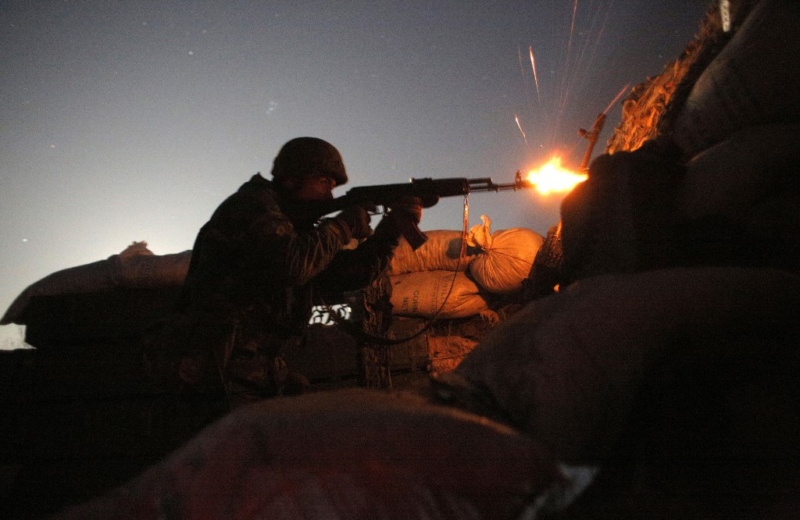Fresh images and videos aired in recent days on social media showed swathes of Russian military forces deployed from all across the country to the Voronezh Oblast, a region bordering Ukraine.
Amid the region’s worst security crisis in years unfolding since late March, the Conflict Intelligence Team (CIT), an online investigations group, have monitored large military convoys concentrated at several spots south of the city of Voronezh, which located some 200 kilometers north of the state border with Ukraine’s Kharkiv Oblast.
The investigators showed numerous images and posts published by local social media users showing echelons of manpower and armored vehicles transported via the regional railroads and highways.
“A large part of the vehicles seen in social media footage belong to Russia’s Central Military District, which means they traveled hundreds or even thousands of kilometers to reach Voronezh,” the group said.
CIT also found evidence suggesting that the forces concentrated near Pogonovo, a local military training range of more than 300 hectares in area and a frequent scene of large combined armed maneuvers.
Later in the day, New York Times visual investigator Christiaan Triebert published on Twitter fresh satellite pictures confirming the large presence of newly arrived Russian military power at the Pogonovo. The images “reveal hundreds of military vehicles at recently formed staging areas,” according to the journalist.
A new Russian Army camp was set up in the Voronezh region bordering Ukraine, @CITeam_en reports. High-resolution satellite imagery obtained by Visual Investigations indeed reveals hundreds of military vehicles at recently formed staging areas. 🛰️📸: @Maxar https://t.co/GW2p4dcxhy pic.twitter.com/GlW9u9Xb4Q
— Christiaan Triebert (@trbrtc) April 8, 2021
Earlier, CIT also asserted that the concentration of Russian troops in areas close to the Ukrainian borderline and in occupied in Crimea detected since late March is the largest since 2015.
The Kremlin continues calling this massive military buildup, which strongly alerted Ukraine, NATO, and the United States, as nothing but routine maneuvers. On April 6, the Russian military announced over 4,000 various maneuvers and drills to be held all across the country as part of a campaign to inspect the armed force’s combat capacity.
Besides, in a series of fiery outbreaks, the Kremlin also openly threatened intervention in case of Ukraine’s attempt to regain Russian-occupied Donbas, which prompted Ukraine’s military intelligence to warn of possible Russian armed provocations for the sake of justifying an all-out invasion of Ukraine.
Upon that, Ukraine has repeatedly constituted the impossibility of an all-out offensive in Donbas as an instrument to end the protracted static war continuing since, saying that the military option would entail an unacceptable civilian death toll.
“The Russian deployment in Voronezh region is concerning primarily because not only can’t it be explained with exercises.” the CIT also said.
“But it is just as unlikely that it is done in preparation for a “Ukrainian offensive”…(in case of which) it would make more sense to deploy them not to Voronezh, but to Rostov region to the south. Thus, the Russian military posture at least in the Voronezh region is rather offensive than defensive.”
“However, there is still no certainty that a Russian invasion of Ukraine-controlled territory is imminent. If it is indeed the Kremlin’s goal to put pressure on Kyiv and Washington, then it would be logical to deploy the Russian troops in a sufficiently threatening manner — such as across the border from Ukraine’s Kharkiv and northern Luhansk regions.”
President Volodymyr Zelensky on April 8 paid a visit to troops in the war zone, following a series of deadly clashes with Russian-backed militants that claimed at least 4 Ukrainian fatalities over the last three days.
Meanwhile, the Kremlin on April 8 continued throwing warlike rhetoric against Kyiv, with the deputy head of Russia’s presidential administration Dmitriy Kozak calling the allegedly potential Ukrainian offensive in Donbas “the beginning of the end of Ukraine.”
The official also again confirmed that Russian “might be inclined to join the fight in Donbas and protect its citizens.” At the same time, Kozak also admitted that Kyiv has no real intentions to launch a major battle in the breakaway, calling the crisis a Ukrainian “PR campaign” that may nonetheless trigger a new phase of mass warfare.
Threats towards Kyiv were repeated by President Vladimir Putin of Russia, who in a phone conversation with German Chancellor Angela Merkel accused Ukraine of “recent provocations that purposefully escalate the front line situation.”
Nonetheless, according to fresh reports, the German leader offered a strong response regarding the concentration of Russian military power semi-surrounding Ukraine.
“The Chancellor demanded that this build-up be unwound in order to de-escalate the situation,” the Berlin statement reads.



